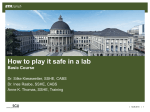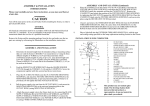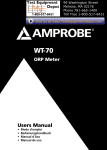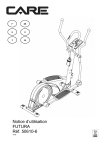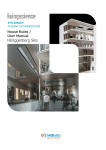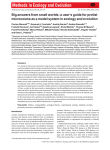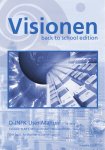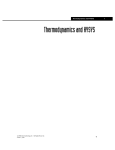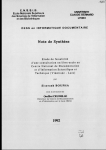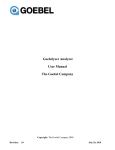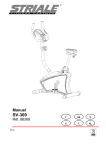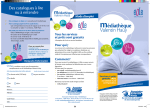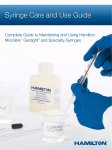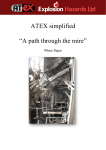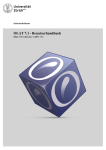Download Main hazards in a chemical laboratory
Transcript
How to play it safe in a lab Basic Course October 28, 2015 Evelyn Mächler, SSHE, CABS Sebastian Ziegler, SSHE, CABS | | 1 Program 1. Main hazards in a laboratory Part 1: chemical products Part 2: other hazards 2. Risk analysis - Where to find information 3. Dealing with hazards: Minimization of risks 4. Personal Protective Equipment 5. Emergencies - How to react 6. Questions | | 2 Coffee break 10 o’clock / 11 o’clock in Polysnack HG F-Stock mention «how to play it safe in a lab» at the cash desk | | 3 Main hazards in a chemical laboratory: Part 1: Chemical products | | 4 Chemical products in everyday life / at work Chemicals can be found almost everywhere, e.g.: cleaning agents solvents batteries medical products / drugs fuels matches photography … | | 5 Attention: Chemicals are also hazardous… fires burns chemical burns intoxications allergies explosions damages of skin or tissues damage of materials danger for the environment | | 6 Main hazards in a chemical laboratory: Part 1: Chemical products Labeling | | 7 Labeling Danger symbols Labels on bottles | | 8 Hazard and safety indications on lab doors | | 9 Labeling Prohibition signs | | 10 Labeling Warning signs On entrance doors On cabinets | | 11 Labeling Mandatory signs On entrance doors On machines | | 12 Right or wrong? | | 13 Main hazards in a chemical laboratory: Part 1: Chemical products How to work with chemical products in a lab | | 14 How to work with chemical products in a lab: Fume hood source: http://www.waldner-lab.de/de/ service/galerie/fotos.aspx Laminar flow Glove Box source: http://ssfp.unileoben.ac.at/Laminar.htm source: http://en.wikipedia.org/wiki/ File:Glovebox.jpg | | 15 Fume hoods Why working in a fume hood? Prevent toxic, harmful or corrosive gases, vapors, dust particles, aerosols, etc from spreading into the ambient air Prevent formation of explosive gas mixtures inside a fume hood Protection against splashes and splinters When working in a fume hood? When conducting experiments/procedures which might release harmful or hazardous gases, vapors, dust and aerosols | | 16 Fume hoods Some basic rules: Check fume hood is ON (with a piece of paper) Only work in laboratory scale Always wear PPE such as safety glasses, labcoat (and gloves) Keep front window closed Fume hood ≠ storage place | | 17 Fume hoods exhaust front window Keep front window closed! | | 18 Fume hoods exhaust front window Make sure that airflow / circulation is not disturbed by large equipment in the fume hood ! | | 19 Fume hoods exhaust front window Place heat sources in the rear part of the fume hood! | | 20 What is wrong? | | 21 Glove box source: http://en.wikipedia.org/wiki/ File:Glovebox.jpg What is a glove box? Sealed container to manipulate compounds / objects in a separate atmosphere Objects / substances have to be introduced into and removed via an air-lock | | 22 Glove box When working in a glove box? To work with hazardous substances in a specially filtered atmosphere To manipulate substances in an inert gas atmosphere (e.g. argon, nitrogen) | | 23 Laminar flow box Functional principle: Room air is sucked in the laminar flow box and filtered (e.g. HEPA-filtration) creation of a sterile atmosphere Laminar flow reduces turbulences of particles present in air and discharges them downward Recirculation of air within the box to the room Laminar flow box ≠ fume hood | | 24 Laminar flow box When working in a laminar flow box box? Need of a sterile atmosphere often biological work source: http://zocker0815.npage.de/gedanken.html biosafety cabinets Need of a dust free atmosphere optics analytics electronics | | 25 Main hazards in a chemical laboratory: Part 1: Chemical products Hazardous chemicals | | 26 Acids and Bases HCl HNO3 H2SO4 H3CCOOH HF … http://nutritionalmuscletesting.com/web_images/acid_20base_20balance.gif NaOH KOH Ca(OH)2 NH3 H3CNH2 … | | 27 Chemical burn Danger: Acids can cause chemical burns on the skin Model: Nitric acid on meat – with and without protective gloves | | 28 Chemical burn Observations: The piece of meat turns immediately white when it gets in contact with the acid chemical burn The piece of meat protected by a glove isn`t chemically burned Also the glove remains intact | | 29 Chemical burn Consequences: Wear gloves and safety glasses Work in a fume hood | | 30 Hydrofluoric acid – HF Highly corrosive liquid Strong contact poison Chemical burn of lower tissue layers, even bones Symptoms of exposure may not be immediately evident http://www.glasmalerei.de/techni ken/aetzen/ aetzen-1/index.html interferes with nerve function initial chemical burns may not be painful accidental exposures can go unnoticed Rule: a burn the size of your palm is fatal (40% HF ) | | 31 Sodium hydroxide – NaOH Can decompose proteins and lipids in skin, eyes … chemical burn Dissolution of solid NaOH exothermic, resulting heat can cause heat burns or ignite flammables Exothermic reaction with acids Corrosive to some metals, e.g. Al produces flammable H2 gas | | 32 Ammonia Characteristic pungent smell Irritating, caustic effects on eyes and skin Easily resorbed through the skin Inhalation irritating / harmful effects on the respiratory system (acute effect) respiratory disorder (chronic effect) Oral incorporation severe damages of the digestive tract Pungent smell = first warning Poisoning with ammonia occurs seldom. | | 33 Solvents acetone acetonitrile dichloromethane ethanol ethyl acetate hexane tetrahydrofuran … | | 34 Acetone Degreases the skin Only slightly toxic in normal use Most hazardous property: extreme flammability Temperature greater than flash point air/acetone mixtures (97.5/2.5-vol% – 87.2/12.8-vol%) may explode or cause a flash fire Vapors can ignite sources and flash back Static discharge may ignite acetone vapors | | 35 Solvents Danger: Damage of material or deleterious effects on skin Consequences: Skin protection and care comprises: Use of gloves Use of hand cream | | 36 Acetonitrile Metabolized to hydrogen cyanide the onset of toxic effects is delayed about 2–12 hours Symptoms: breathing difficulties, slow pulse rate, nausea, and vomiting Serious cases: convulsions and coma, followed by death from respiratory failure source: http://www.topfruits.de/html_datasheet.php? products_id=1810 source: http://www.hoio.ch/index.php?id=1103 | | 37 Dichloromethane (DCM) High volatility Acute inhalation hazard Metabolized to carbon monoxide eventually CO poisoning Acute exposure by inhalation optic neuropathy, hepatitis Prolonged skin contact possibly dissolving of the fatty tissues in skin skin irritation or chemical burns DCM might be carcinogenic | | 38 Hexane Acute toxicity: low, mild anesthetic first a state of mild euphoria followed by somnolence with headaches and nausea Chronical toxicity: well known in humans Extensive peripheral nervous system failure Initial symptoms: tingling, cramps in the arms and legs then: general muscular weakness Suspected of damaging fertility | | 39 Tetrahydrofuran (THF) Penetrates the skin rapid dehydration Serious eye irritation Respiratory irritation Greatest danger: tendency to form highly-explosive peroxides on storage in air often inhibitor added in commercial samples THF should not be distilled to dryness, because the explosive peroxides concentrate in the residue | | 40 Inflammable chemicals Danger: Inflammable substances can ignite or be ignited and cause fires and burns http://www.arbeitsschutzfilm.de/mediath ek/youtube/explodierende-gasflaschenauf-der-autobahnvideo_984c63331.html | | 41 Inflammable chemicals Explanation: Ignition point Zündpunkt Combustion Brennpunkt point Flammpunkt Flash point Flash point: Vapors are ignited by an ignition source combustion stops after removal of the ignition source Combustion point: Vapors are ignited by an ignition source continue burning after removal of the ignition source Ignition point: Vapors ignite spontaneously | | 42 Inflammable chemicals Explosive mixtures: no more explosive substance LEL [%vol] UEL [%vol] ether 1.7 36.0 ethanol 3.4 15.0 gasoline 0.6 8.0 hydrogen 4.0 75.6 upper explosion limit (UEL) EXPLOSION lower explosion limit (LEL) not yet explosive | | 43 No smoking | | 44 No food and drinks in a lab | | 45 What is wrong? | | 46 What is wrong? | | 47 What is wrong? | | 48 Main hazards in a chemical laboratory: Part 1: Chemical products Waste disposal | | 49 Disposal of “normal” waste Minimize waste Separate waste Paper and cardboard Glass and bottles PET Metal Electrical waste Used CD/DVDs | | 50 Disposal of hazardous waste Minimize waste Use official containers Separate waste Acids Bases Mercury the smellier the waste the more it needs to be collected separately Chlorinated solvents Non-chlorinated solvents … | | 51 Disposal of hazardous waste CNB Wednesday: 09 - 11 am Contact: Martin Frei [email protected] HCI Monday - Friday: 2 - 4 pm Contact: Guido Krucker [email protected] HPL: once per month Campus Zentrum Science City, Campus Hönggerberg | | 52 Waste? | | 53 Waste! source: http://sprachstammtischemuenchen.jimdo.com/ blog-latest-news/all-blog-posts/ | | 54 Main hazards in a chemical laboratory: Part 1: Chemical products Apparently harmless substances | | 55 Apparently harmless substances: really harmless ↔ inherent dangerous Example 1: Nitrogen (N2) The air consists of almost 80% nitrogen Nitrogen is not flammable, not toxic, odorless absolutely harmless??? | | 56 Liquid nitrogen Danger: Apparently harmless substances Risk is underestimated Model: Rose in liquid nitrogen | | 57 Liquid nitrogen Observations: The rose cracks after removing it from the liquid nitrogen bath (-196 °C) Even very cold substances can be liquid cryogenic liquids | | 58 Liquid nitrogen Consequences: Avoid direct contact to cryogenics (also to tubing) Wear safety glasses and special gloves source: http://www.phys.ethz.ch/phys/dep/ dienste/techbetr/verfluss/ | | 59 Liquid nitrogen Yet another danger: 1 Liter of liquid nitrogen about 700 liter of gas! Displaces oxygen (O2) from the air content of O2 in the air ca. 21% source: BG RCI What happens? Normal ambient air < 16% Expired air Loss of performance < 11% Fire gets extinguished < 10% Sudden loss of consciousness < 6-8% Death by asphyxiation within minutes | | 60 Apparently harmless substances: really harmless ↔ inherent dangerous Example 2: Compressed Air | | 61 Gas cylinders Danger: Underestimation of „secondary“ hazards Model: Valve of compressed air cylinder breaks source: Schweizerischer Feuerwehrverband | | 62 Gas cylinders Consequences: Use personal protective equipment Avoid heat sources next to gas cylinders Secure gas cylinders against falling Always use the correct pressure reducing valve When not in use: safety cap Never use „brute-force“ when handling valves Never lubricate valves Label empty and defective cylinders | | 63 What’s wrong? source: BG RCI | | 64 What’s wrong? source: BG RCI | | 65 Main hazards in a chemical laboratory: Part 2: Other hazards | | 66 Some other common hazards in a (chemical) lab: Lasers Heat sources Magnetic fields Biological agents (pathogens, GMO) Centrifuges High voltage, power current Vacuum or high pressure Sharps and glassware … | | 67 Main hazards in a chemical laboratory: Part 2: Other hazards Lasers | | 68 Laser (non-ionising radiation) 4 Classes: Class 1 - Safe under all conditions of normal use Class 2 - Visible-light lasers - Fairly safe blink reflex will limit the exposure to no more than 0.25 seconds (if not viewed through optical instruments) → Do not stare into beam source: luminapolis.com/en/2010/01/deutschenationalbibliothek-interaktive-laserskulptur/ | | 69 Laser (non-ionising radiation) Class 3 Class 3 R - Is considered safe if handled carefully, with restricted beam viewing - The maximum permissible exposure can be exceeded → low risk of injury Class 3 B - Hazardous if the eye is exposed directly, in some cases it can be hazardous for the skin source : www.dresden-forscht.de/index.php?id=49 → Wear protective eyewear | | 70 Laser (non-ionising radiation) Class 4 - Can cause permanent eye damage and burn the skin as a result of direct or diffuse beam viewing. - May ignite combustible materials, and thus may represent a fire or explosion risk → Wear protective eyewear | | 71 Laser Labelling Warning sign Indication of laser class and instructions | | 72 Additional labelling – laser classes 3B and 4 Laser data Laser medium Wave length Duration of emission Radiation efficiency Radiation energy Warning lamp in front of the door = DON`T ENTER. source: http://www.goebellaser.de/html/warnen.html source: http://www.laser2000.de/ index.php?id=370356 | | 73 Main hazards in a chemical laboratory: Part 2: Other hazards Heat sources | | 74 Heat sources in a lab open fire (Bunsen burner) hotplate sand bath oil bath light sources (Lasers, light bulbs) … | | 75 Heat sources in a lab Basic rules: Don’t touch hot surfaces (this rule seems to be quite obvious, but…) Hot surfaces look the same as cold surfaces mark them with a warning sign Check electric installation (temperature control, etc.) regularly | | 76 Heat sources in a lab Some more rules: Caution: no water near oil bathes! preferably use DrySyn systems Keep flammables and gas cylinders away from heat sources Beware of secondary hazards (e.g. Laser beam, open gas,…) source: http://www.dechema.de/ Presse/Pressemitteilungen/Archiv/ 2008/42_2008.html | | 77 Main hazards in a chemical laboratory: Part 2: Other hazards Magnetic fields | | 78 Magnetic fields Hazardous effect depends on the strength of the magnetic field | | 79 Magnetic fields Protective measures Mark the dangerous zone (line on the ground) Keep out if you are not authorized Warning signs, prohibitions | | 80 Main hazards in a chemical laboratory: Part 2: Other hazards Vacuum | | 81 Vacuum Implosion Protective measures: shielding windows, safety glasses , etc. Never evacuate cylindrical or cubic glassware (only round flasks) Make sure that equipment is vacuum-proof | | 82 Main hazards in a chemical laboratory: Part 2: Other hazards High pressure | | 83 High pressure Explosion Hazard depends on physical condition: 200 bar liquid (e.g. HPLC) less hazardous than 200 bar gas pressure (e.g. N2 gas bottle) Make sure that equipment is high-pressure-proof Reactions / procedures with more than 10 bar gas pressure work in high pressure labs inform SSHE | | 84 Main hazards in a chemical laboratory: Part 2: Other hazards Sharps | | 85 Sharps: Syringe needles, scalpels Injuries Potential source of contamination with chemical, biological, infectious, radioactive material Needle-stick injuries Often occur when recapping needles → immediately dispose of syringe and needle → Never place any sharps in the ordinary trash bin Common causes for lacerations → Picking up contaminated pieces of broken glassware → Working with damaged glass equipment | | 86 Special Sharp Containers Unbreakable, puncture-proof, sealable Place sharps container within easy reach Don’t walk around when carrying sharps Dispose of sharps immediately after use. Don’t overfill sharps container Seal it when it is ¾ full and take it to the hazardous waste disposal station. | | 87 Contaminated Sharps Sharps contaminated with infectious material: Have to be inactivated before disposal collect in autoclavable sharps containers autoclave dispose | | 88 What is wrong? | | 89 Risk analysis – where to find information? | | 90 For standard procedures: Checklists All important issues to be checked on one list For general procedures and hazards: available from the SUVA (www.suva.ch) | | 91 Where to find information on specific hazards Machines / equipment user’s manual, supplier Laboratory hazards DGUV “Working Safely in Laboratories – Basic Principles and Guidelines” http://bgi850-0.vur.jedermann.de/index.jsp ETH SSHE factsheets, guidelines, concepts https://www.ethz.ch/services/de/service/sicherheitgesundheit-umwelt/dokumente.html | | 92 Where to find information on chemicals On the product label on the bottle / can In the MSDS (Material Safety Data Sheet) • Substance, production company • Personal protective equipment (PPE) • Detailed contents • Physical and chemical properties • Possible hazards • Toxicology • First aid measures • Ecotoxicology • Fire fighting measures • Transportation • Handling and storing • Legal aspects | | 93 Where to find information on chemicals Online databases e.g. GESTIS (also available as Apple and Android app) For non-commercial new chemicals: scientific publications | | 94 Dealing with Hazards: Minimization of Risks | | 95 Dealing with hazards / minimization of risks Before the experiment: Check and consider safety instructions Define exactly the work flow and procedures Check experimental setup | | 96 Minimization of risks During the experiment: Apply safety measures Use protective equipment Protect people, environment and values | | 97 Minimization of risks After the experiment Clean up your workplace, sort / recycle your waste In general: think before you act Turn off all media (cooling water, electricity, gas, etc.) In case of doubts or questions: contact an expert | | 98 Dealing with hazards: The STOP concept Decreasing efficacy Strategic measures Technical measures Organizational measures Personal protective equipment | | 99 STOP: Strategic measures Check if there are less hazardous products available (substitution) e.g. heptane or pentane instead of hexane Check for safer procedures e.g. “DrySyn” instead of oil bath | | 100 STOP: Strategic measures Check for “hidden” / secondary hazards e.g. laser class 4: produces not only light, but might also cause fire Preferably use small quantities of chemicals e.g. small-scale reactions; large scale only with optimized parameters | | 101 STOP: Technical measures Separate work areas some work (e.g. radioactivity, biohazard) need special labs Gas detection when working with hazardous gases or liq. N2 (depending on quantity) contact SSHE | | 102 STOP: Technical measures Shielding e.g. shatter protection shields, lead shields for gamma-radiation Ventilation / fume hood / local exhaust ventilations no hazardous work in non-ventilated areas handling harmful chemicals, soldering | | 103 STOP: Organisational measures Instruction / training / SOP’s Mandatory (supervisor is responsible for instruction / training, employees have to work according to them) Also for students, visitors, maintenance personnel, etc. Set up SOP’s for specific procedures | | 104 Courses and seminars organized by SSHE gas cylinders biosafety laser seminar radiation protection disposal of hazardous waste working with nanoparticles fire fighting training etc. SSHE course calendar: https://www.ethz.ch/services/de/service/sicherheit-gesundheitumwelt/aus-und-weiterbildung/kurskalender.html | | 105 STOP: Organisational measures Labels / signs Hazard symbols, warning signs, obligations, access restriction (available from the SSHE [email protected]) Employees have to know what they mean and how to behave Use signs when necessary but never warn of non-existing hazards! | | 106 Lab safety – some general rules Entrance only for people working in the lab No food and drinks in the lab Disorder amplifies the risk keep your working area clean source: http://nobel.scas.bcit.ca/ debeck_pt/science/safety.htm Never do risky work alone there must always be a second person in the same room „Hot things often look the same as cold things“ be careful Experiments running over night secure all media (cooling water, etc.) | | 107 Disorder amplifies the risk | | 108 Risky work | | 109 Never do risky work alone source: http://de.wikipedia.org/ | | 110 Lab safety – some more rules Wear appropriate clothing long trousers, robust and closed shoes Wear appropriate PPE (safety glasses, lab coat, etc.) What we want to avoid ! source: http://nobel.scas.bcit.ca/debeck_pt/science/safety.htm | | 111 Overnight | | 112 Personal Protective Equipment | | 113 STOP: Personal protective equipment – Lab coats Protection of lab personnel, environment and samples Mandatory in all (micro-) biological and chemical labs and when handling hazardous substances (e.g. liq. N2, special waste, etc.) Not allowed: at desk, in cafeteria, in offices, etc. To be washed regularly (for laundry service: contact SSHE) In biosafety labs level 2: disinfect after contamination | | 114 EYE PROTECTION | | 115 Safety goggles Protection of lab personnel Mandatory when Risk of splashes / aerosol production / dust production Spill cleanup Handling chemicals (including solvents) or cryogenic liquids Working with lasers (class 3B and 4) Cutting glass Don‘t wear contact lenses (not even in combination with safety goggles) When 1 person is doing such work in the lab, all others have to wear safety goggles, too! | | 116 Safety goggles Optically corrected safety glasses can be obtained via SSHE Normal glasses don’t replace safety goggles! | | 117 HAND PROTECTION | | 118 Gloves Protection of lab personnel, environment and samples Regularly check and replace re-usable gloves, never re-use single-use gloves Mandatory when contact with hazardous substances or pathogenic material cannot be excluded handling cryogenic liquids (liquid N2 etc.) or dry ice Replace gloves after max. 2 h, wash hands and use hand cream | | 119 COLD | | 120 Protective Gloves against Cold Norm EN 511: for all gloves which protect against EN 511:2006 convection cooling and contact cooling up to -50°C Additionally, these gloves must at least belong to 231 performance class 1 Convection according to norm EN cooling (0-4) Contact 388 regarding abrasion cooling (0-4) resistance and tear propagation Water permeation test (0/1) | | 121 Protective Gloves against Cold | | 122 Protective Gloves against Cold | | 123 Liquid Nitrogen After the removal of the blisters 2 weeks after the incident Source: P. Roblin, A. Richards, R. Cole, Burns 23, 1997, 638-640 Handling of test tubes with tongs/tweezers, which were deep frozen in liquid nitrogen ‒ person wore protective gloves No direct contact with liquid N2 Years of working experience | | 124 CHEMICAL RISKS | | 125 Protective Gloves against Chemical Risks Waterproof, only little protection against chemical risks; NOT «resistant against chemicals» Good degradation and penetration characteristics, protects against permeation by chemical substances Degradation: durability, soaking Penetration: A chemical substance penetrates a damaged spot in the material / porosity, through leaking stitching (macroscopic permeation) Permeation: A chemical permeates the material of the glove on a molecular level breakthrough time (min – h) | | 126 Requirements for gloves Aim: Unimpaired working performance and, at the same time, highest possible protection Ergonomic fit High-quality materials Practice-oriented in terms of tactility, grip, skid resistance, «interior climate» Durability, lifetime | | 127 Protective Gloves against Chemicals Glove considered resistant to chemicals, when it reaches a protective index of at least class 2 against three of the twelve test substances Test substances (A) Methanol, (B) Acetone, (C) Acetonitrile, (D) Dichlormethane, (E) Carbon disulfide, (F) Toluene, (G) Diethylamine, (H) Tetrahydrofurane, (I) Ethylacetate, (J) n-Heptane, (K) NaOH 40 %, (L) H2SO4 96 % Protective index according to EN 374-1 breakthrough time Class 1 > 10 min Class 2 > 30 min Class 3 > 60 min breakthrough time Class 4 > 120 min Class 5 > 240 min Class 6 > 480 min | | 128 Protective Gloves against Chemical Risks | | 129 Protective Gloves against Chemical Risks | | 130 Comparison of Different Glove Materials Nitrile Latex PVA Water Good resistance Good resistance Weak resistance Acetone Weak resistance Medium resistance Weak resistance Trichlorethylene Weak resistance Weak resistance Good resistance NaOH, 40% Good resistance Good resistance Weak resistance Toluol Medium resistance Weak resistance Good resistance | | 131 Chemical Resistance NitroChem Plus Ethanol Ethidium bromide in H2O Ethyl acetate Formaldehyde 35% Gasoline Glutar dialdehyde Heptane 98% + 1-Butanol 2% Hexane HCl Breakthrough time in minutes Protective index 0-6 8 0 > 480 6 <1 0 > 480 6 84 3 > 480 6 9 0 > 480 6 126 4 | | 132 Sources of Information Safety data sheet GESTIS Substance Database http://gestisen.itrust.de/nxt/gateway.dll?f=templates$fn=default.htm$vid=gestiseng:sdbeng http://www.ansell.com http://kcl.de http://www.mapa-professionnel.com | | 133 Acetone (MSDS) – protection of hands Wear protective gloves Material of gloves Butyl rubber, thickness: 0,7 mm The selection of the suitable gloves does not only depend on the material, but also on further marks of quality and varies from manufacturer to manufacturer. Penetration time of glove material Value for the permeation: Level ≥ 6 The exact breakthrough time has to be found out by the manufacturer of the protective gloves and has to be observed. As protection from splashes gloves made of the following materials are suitable: Natural rubber | | 134 Gloves To be removed before Working at desk / office space Touching computer keyboards, door handles, telephones, etc. Leaving the lab How to remove gloves | | 135 RESPIRATORY PROTECTION | | 136 Respiratory protection: Respirators Some basics: Mandatory when risk of toxic gases or chemical vapors / smoke All potentially exposed people have to wear one 2 Types: Dependent on circulating air Independent of circulating air | | 137 Respiratory protection: Respirators Masks dependent on circulating air: (A) Full face masks (B) Half masks source: http://www.ritzarbeitsschutz.de/industrie/atemsc hutzmasken/halbmasken/index.ht ml source: http://www.ppsvertrieb.de/maske-sferasilikon-vollmaske.html source: http://www.acemarkenshop.com source: http://www.schutzbusshop.de/MoldexHalbmasken-Set-8982-mit-A1B1E1K1-P3-R-DFilter | | 138 Respiratory protection: Dust Masks Some basics: Mandatory when risk of hazardous dusts / aerosols All potentially exposed people have to wear one Doesn’t protect against chemical vapors or toxic gases Doesn’t protect against lack of oxygen Doesn’t replace a fume hood! Surgical masks ≠ dust masks! | | 139 Dust Masks Surgical face mask (no FFP class) Filter classes: 3 classes according to European standard EN149:2001(2009) Filter class Penetration limit (@95L/min air flow) Inward leakage rate FFP1 > 80% < 22% FFP2 > 94% < 8% FFP3 > 99% < 2% Make sure the dust mask suits you (not only filter class is important) FFP 3: different mask types | | 140 Emergencies - How to react | | 141 Emergency Numbers Important emergency numbers on all ETH-phones ETH Emergency Desk (24/7): from internal phones: 888 from external phones: 044 342 11 88 External services (0)118 fire brigade (0)144 ambulance (0)117 police Intoxication (0)145 Tox Center (councelling) | | 142 Possible Emergencies Accident Fire | | 143 Accident | | 144 Alert (phone) Where did it happen? What did happen? Who / How many is / are involved? When did it happen? How did it happen? What else could be important? Who is calling? | | 145 First Aid First-Aid-Zip-Bags in corridors / staircases Eye showers Emergency showers Help the internal First-Aid-Team | | 146 Eye showers | | 147 Key Rules First priority: Always YOUR OWN SAFETY! Stay calm, call 888 Secure the area Apply first aid & wait for ETH first aid team Give necessary information to emergency services (but to nobody else!) no contact to media! Do not walk around avoid contamination Do not clean the area where the accident happened might be evidence ! | | 148 Fire | | 149 Alert (phone / fire alarm button) Where did it happen? What did happen? Who / How many is / are involved? When did it happen? How did it happen? What else could be important? Who is calling? | | 150 Rescue People, Close all doors Leave the building immediately Close doors! Go to Assembly Point Hönggerberg: HXE Zentrum: ASVZ-Sporthalle | | 151 Assembly Point ETH Hönggerberg In front of building HXE | | 152 Assembly Point ETH Zentrum In ASVZ – Sporthalle | | 153 Fight the fire First priority: Always YOUR OWN SAFETY! Fire fighting training every autumn organized by SSHE Fire fighting equipment in the corridors Extinguishers Sand Fire blanket | | 154 Fire extinguishers | | 155 Further Documentation https://www.ethz.ch/services/de/service/sicherheit-gesundheit-umwelt/dokumente.html#Laborsicherheit | | 156 In Case of Emergency: Apply to Key Rules https://www.youtube.com/watch?v=tSoHs1h0UFk | | 157 Questions | | 158































































































































































